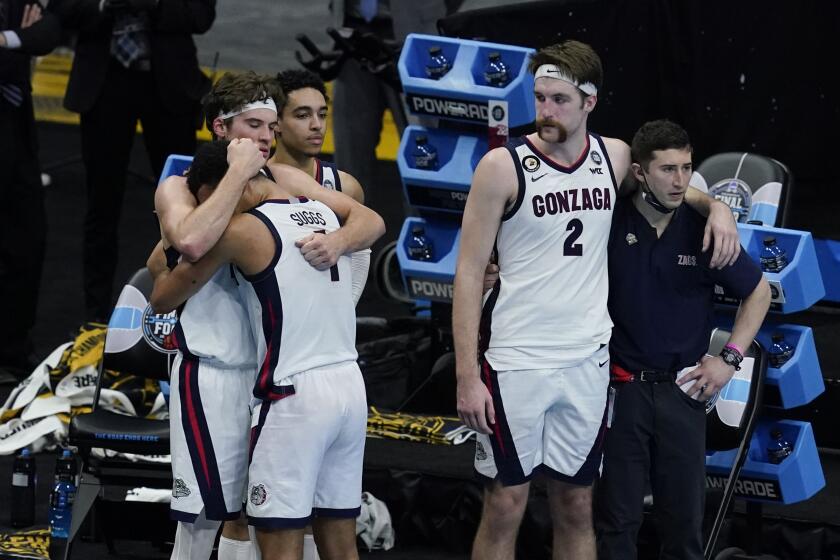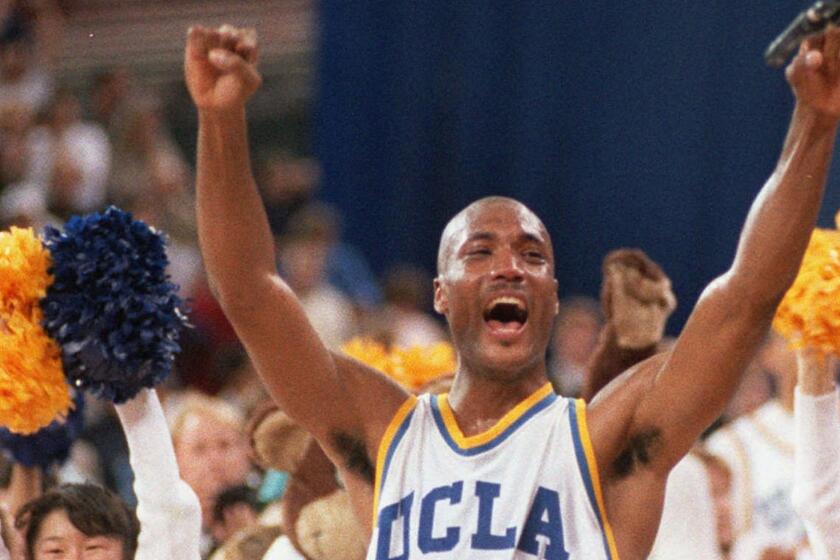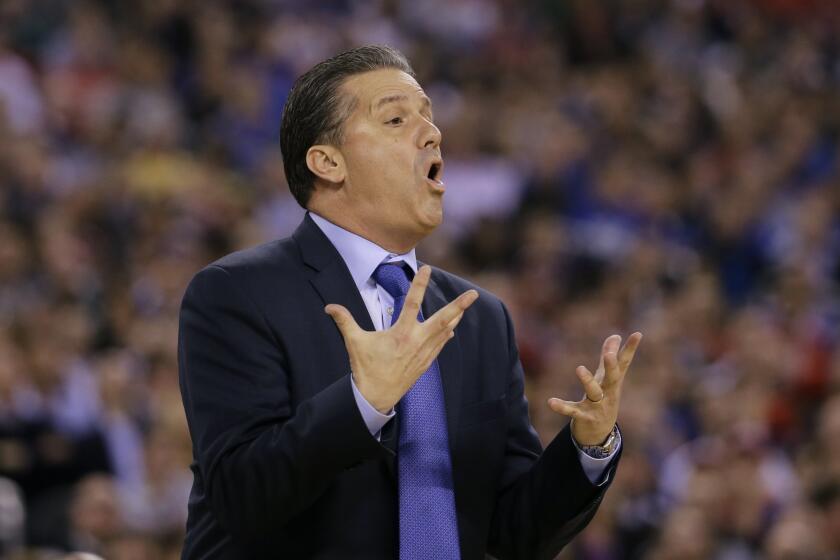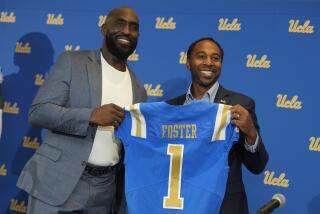This lawsuit has the NCAA staring down extinction. Is that a bad thing?
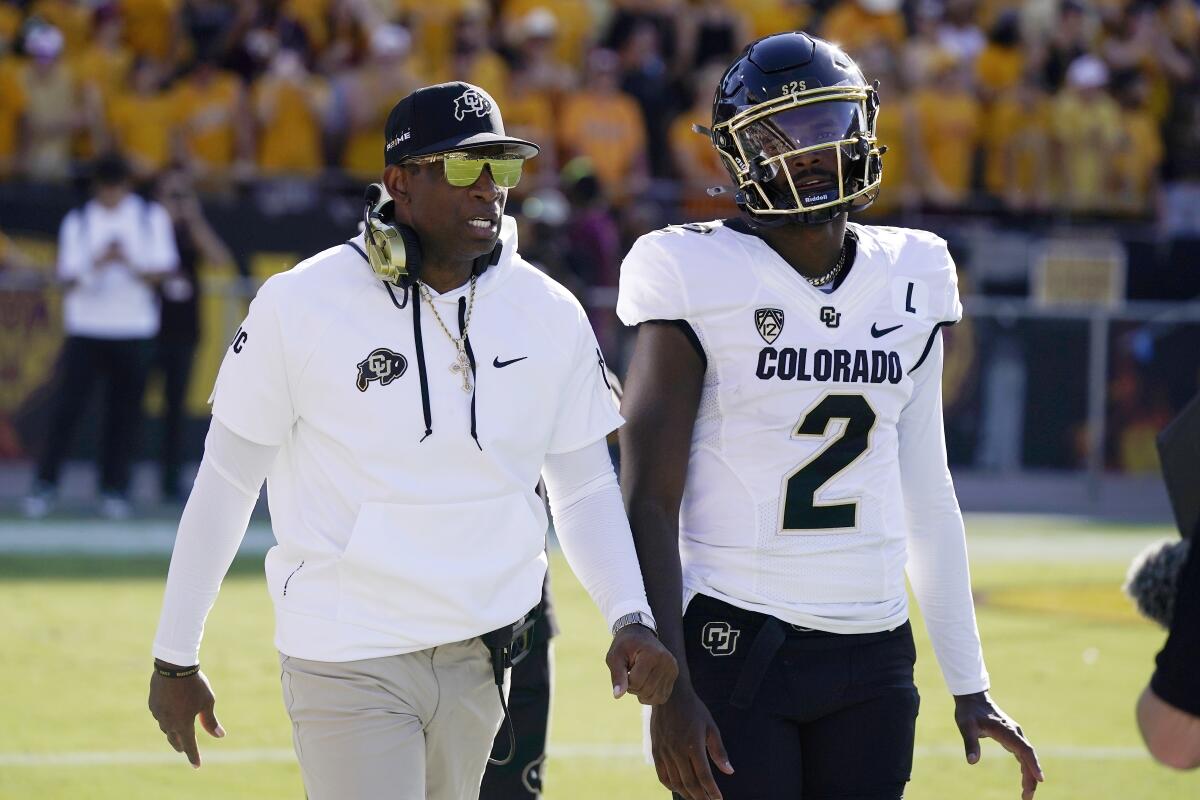
- Share via
There can be few American public institutions more widely detested than the National Collegiate Athletic Assn.
The NCAA spent decades promoting the ideal of the amateur “student-athlete,” barring football and basketball players from compensation while their coaches and university athletic directors collected millions of dollars a year. Its disciplinary system, rife with favoritism and inconsistencies, is honored by member universities more in the breach than the observance.
And when it doesn’t get its way, it hasn’t been shy about bullying — not that it always works, as when it threatened in 2019 to ban California universities from championship games if the Legislature voted to allow payments to those student-athletes.
Nowhere else in America can businesses get away with agreeing not to pay their workers a fair market rate on the theory that their product is defined by not paying their workers a fair market rate.
— Supreme Court Justice Brett Kavanaugh
(The measure in question passed anyway and was signed into law by Gov. Gavin Newsom.)
As it happens, the very issue covered by that legislation — compensation for the use of college players’ “names, images and likenesses,” or NIL for short — is at the center of what the NCAA implies could be an extinction event for the collegiate sports system as we know it today, if not for the NCAA itself.
Get the latest from Michael Hiltzik
Commentary on economics and more from a Pulitzer Prize winner.
You may occasionally receive promotional content from the Los Angeles Times.
The NCAA’s hand-wringing has come about because federal Judge Claudia Wilken of Oakland has certified an antitrust lawsuit naming the association and its five most important regional sports conferences, the so-called Power Five, as a class action.
Wilken designated three classes of plaintiffs: current and former men’s football and basketball players in the Power Five conferences, current and former women’s basketball players in those conferences, and all other current and former athletes who competed on Division I teams prior to July 1, 2021, and have received NIL payments from third parties under the NCAA’s temporary suspension of NIL payment restrictions.
The athletes who brought the case have asked for $1.4 billion in damages, which under antitrust law would be trebled if they win, for a total of $4.2 billion.
A judgment of that magnitude, the NCAA says in an appeal brief, “would necessitate curtailing college sports programs across the country.” It says it would face “intense pressure to settle,” presumably on highly disadvantaged terms — at least for the association, the athletic conferences and the administrators who have been running university programs on a business model dependent on paying athletes virtually nothing.
This problem is the product of the transformation of college football and basketball into big businesses so rich and powerful that they often overwhelm the academic goals of their universities.
The Supreme Court deals the NCAA a major loss on antitrust grounds
Who’s responsible? The NCAA and the universities with big-money programs themselves. They built these enormous financial edifices on a business model based on the players’ free labor.
“The hard work of college athletes,” the plaintiffs observed in their lawsuit, “has translated into billion-dollar television deals, multi-million dollar coaching salaries, extravagant facilities, and lucrative commercial licensing and sponsorship agreements” for the NCAA, its conferences and their executives.
Now that the financial ground is shifting under the feet of the NCAA and the richest athletic programs, they’re feeling the pain from the collapse of their franchise.
The numbers tell the story.
In recent years the Big Ten, Southeastern and Big 12 conferences signed multiyear television deals for football worth a total of more than $12 billion. In 2016, the NCAA renewed its contract with Turner Sports and CBS for broadcast rights to its men’s basketball tournament for $8.8 billion over eight years.
The lawsuit plaintiffs assert that more than 150 football and basketball coaches in the NCAA’s elite Division I earn more than $1 million a year; the best-paid 25 football coaches collect an average of $5.2 million and the top 25 basketball coaches an average of $3.2 million. In fiscal 2021-22, NCAA President Mark Emmert earned nearly $3.3 million, according to NCAA disclosures. Emmert retired this year, but it’s a fair bet that the compensation of his successor, former Massachusetts Gov. Charlie Baker, will be in the same neighborhood.
That should provide context to the NCAA’s long drive to keep student players on a short financial leash, in order to preserve the impression that the players are merely amateurs, playing sports out of love for the game.
The opening of the NIL spigot has provided a bounty for star college football and basketball athletes.
Seven-figure NIL endorsement deals have been signed by marquee players, topped by USC basketball player Bronny James, the son of Lakers star LeBron James, for $5.9 million from Nike and Apple’s Beats by Dre, among other brands; University of Colorado quarterback Shedeur Sanders, the son of former NFL star and current Colorado coach Deion Sanders, for $4.5 million from brands including Adidas and Gatorade; and University of Texas quarterback Arch Manning, the nephew of retired NFL quarterbacks Payton and Eli Manning and grandson of NFL quarterback Archie Manning, for deals totaling an estimated $2.8 million.
Other top players without gilded parentages are also receiving eye-popping deals.
It’s always fun to see a bully get upended in the schoolyard.
The NCAA’s position that amateurism is crucial to maintaining fans’ enthusiasm for college football and basketball has been under attack for the better part of a decade. In 2014, Wilken chipped away at the NCAA’s ban on NIL compensation, in a landmark case launched in 2009 with former UCLA basketball star Ed O’Bannon as lead plaintiff.
Wilken recognized big-college sports as a business, not amateur competition. But her solution was to allow NCAA schools to set up trust funds of several thousand dollars per player per year to hold their shares of the licensing revenue they had earned until graduation. She rejected the plaintiffs’ proposal to allow student-athletes to make commercial endorsements, because she accepts that the NCAA and its member schools should protect the students from “commercial exploitation.”
The NCAA had already sustained two blows in 2021. In June, the Supreme Court ruled narrowly, but unanimously, that the NCAA was subject to antitrust laws and that its restrictions on certain education-related benefits for athletes breached the laws. In a concurring opinion, Justice Brett M. Kavanaugh ridiculed the NCAA’s argument that fans would abandon big-time football and basketball if they knew the players were getting paid.
“Nowhere else in America can businesses get away with agreeing not to pay their workers a fair market rate on the theory that their product is defined by not paying their workers a fair market rate,” Kavanaugh wrote.
In the wake of the Supreme Court ruling the NCAA, perhaps detecting the writing on the wall, temporarily suspended its ban on NIL compensation while working out a system of new rules.
The following September, National Labor Relations Board General Counsel Jennifer A. Abruzzo issued a memo defining scholarship athletes at academic institutions as employees. Calling them “student-athletes” is legally a misclassification, Abruzzo said; in fact, she explicitly refused to accept the term in her memo, on the grounds that it had been coined chiefly “to avoid paying workers’ compensation claims to injured athletes.”
Abruzzo drew from the Supreme Court ruling as well as a sea change in the law and what she called “the societal landscape,” which she said “demonstrate that traditional notions that all Players at Academic Institutions are amateurs have changed.” Her memo opened the door to fairer compensation for athletes and even to giving them the right to unionize.
This May, the NLRB’s Los Angeles office followed Abruzzo’s lead by filing a complaint against USC, the Pac-12 Conference and the NCAA, alleging that they broke the law by misclassifying college athletes in men’s and women’s basketball and football as student-athletes rather than employees. The case is pending.
“The conduct of USC, the Pac-12 Conference and the NCAA, as joint employers, deprives their players of their statutory right to organize and to join together to improve their working and playing conditions if they wish to do so,” Abruzzo said at the time.
The University of Kentucky was knocked out of the NCAA men’s basketball championship by Wisconsin on Saturday, one victory shy of an undefeated record.
The truth is that amateurism in college sports — indeed, the very concept of the student-athlete — has always been clothed in the rosy glow of myth. The meet generally regarded as the first intercollegiate athletic contest, the 1852 Harvard-Yale boat race on Lake Winnipesaukee in New Hampshire, was openly a profit-making event, sponsored by a railroad magnate conniving to gin up tourist interest in the lake and its environs.
In that era, collegiate football was a commercial enterprise employing athletes for pay — “‘tramp athletes’ who ‘roamed the country making cameo athletic appearances’ for pay,” as Justice Neil M. Gorsuch wrote in the 2021 Supreme Court opinion. That system prevailed until 1905, when 18 fatalities on the college gridiron provoked President Theodore Roosevelt to force Harvard, Yale and Princeton to codify rules aimed at protecting players from injury.
Roosevelt’s initiative gave birth to the NCAA. As one of its first acts, the NCAA outlawed payments, direct or indirect, to players, thereby defining players as amateurs. The NCAA rode that concept hard for more than a century. Its lawyers coined the term “student-athlete” in the 1950s, but since under-the-table payments still existed it was offered with a cynical wink.
The NCAA is trying to hold back the tide on two fronts. In its appeal of Wilken’s latest ruling, it is arguing that the judge was wrong to certify the three classes of plaintiffs. College players don’t have the common characteristics needed for a class action, the NCAA asserts; nor would it be fair to apportion, say, revenues from a TV deal evenly among all players on a team.
“The value of NIL is inherently tied to each athlete’s unique status and characteristics,” it told the appeals court. “A star quarterback can plainly command more money for the use of his image on the cover of a video game than an unheard-of, backup offensive lineman.”
The NCAA’s second front is on Capitol Hill. The association has been trying to persuade Congress to step in. In an appearance Oct. 17 before the Senate Judiciary Committee, the NCAA’s Baker asked the lawmakers to overrule laws in 30 states governing NIL payment rights by enacting a federal law.
More tellingly, Baker asked the senators to enact a law affirming that “student-athletes ... are not employees of an institution” — in other words, to overturn the NLRB’s doctrine in a way that would stifle the earning rights of most players and eliminate such threats as unionization.
“College sports are a uniquely powerful and beloved institution,” Baker said.
How often have we heard this before? It’s a rare industry that doesn’t come to Capitol Hill pleading that it’s so special that it deserves a tailor-made system of laws and regulations. Baker may claim that his industry is unique, but he sounds exactly like every other business leader looking for a legal bailout.
The NCAA is trapped in a morass of its own making. Its century-old business model has come face to face with 21st century realities, and it needs to deal with the world as it is, instead of trying to keep living in a world of its own.
More to Read
Get the latest from Michael Hiltzik
Commentary on economics and more from a Pulitzer Prize winner.
You may occasionally receive promotional content from the Los Angeles Times.

